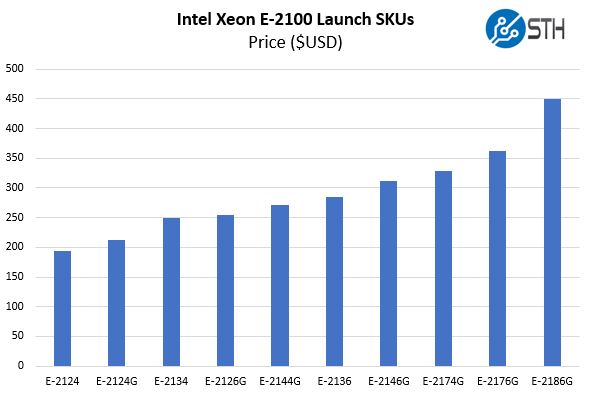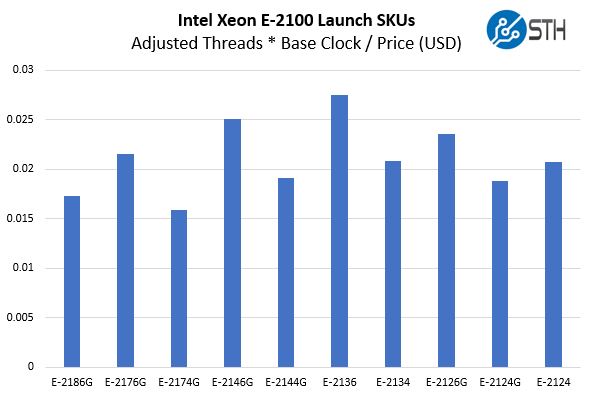Intel Xeon E-2134 Power Consumption
We wanted to post a few figures from our testing that show the real selling point of the chips, low power.
Idle is around 31W and maximum power consumption hits just under 99W in our test bed. Although the increase in TDP does not translate directly to increased power consumption, the Intel Xeon E-2134 we can recommend for extremely power constrained environments like 1A in 110V or 120V rack deployments. For the low-cost colocation world, this is a viable option.
Note these results were taken using a 208V Schneider Electric / APC PDU at 17.7C and 72% RH. Our testing window shown here had a +/- 0.3C and +/- 2% RH variance. We double-checked on our 120V racks and were able to get power consumption over that common 1A threshold.
Intel Xeon E-2134 Market Positioning
Thes chips are not released in a vacuum instead, they have competition on both the Intel and AMD sides. When you purchase a server and select a CPU, it is important to see the value of a platform versus its competitors.
Intel Xeon E-2134 v. Intel Alternatives
Comparing generation on generation, the Intel Xeon E-2134 is a major improvement over the Intel Xeon E3-1230 V6. Hands down, if you are buying or leasing a server you will want the new Intel Xeon E-2100 series over the Xeon E3-1200 V6 series at the same cost. You can read about how the lines evolved in our piece Looking back at Intel Xeon E3-1200 V1-V6 to the New Xeon E-2100. That will show some of the incremental improvmeent strategy Intel has deployed for almost a decade and continues (in the quad core arena) with the Xeon E-2134.
The Intel Xeon D-2100 series still has some major advantages. The Intel Xeon D-2100 series can utilize higher capacity RDIMMs, has more memory bandwidth, and has 10GbE NICs built-in. It is hard to discount that value. The same comparison would likely apply to the Intel Xeon Scalable family where one gets more clock speed with the Intel Xeon E-2186G but misses on the platform benefits. There is a huge delta in what you can do from a platform perspective on these other platforms.
Compared to the Intel Atom C3000 series, the Intel Xeon E-2134 does not have all of the same platform features but is much faster in single-threaded workloads. The larger and more robust compute cores (as seen in our GROMACS test for example), and higher frequencies make this an option for low-cost low power 1U servers.
The biggest competition is perhaps from the Intel Xeon E-2100 line itself. Here is a view of what the line looks like strictly comparing list prices.

Here is another chart to guide the discussion regarding value assiming that the Intel Xeon E-2100 series hyper-threads are worth about 30% more performance than a physical core thread.

Here the Intel Xeon E-2134 is a fairly average value part. It is the best of the four core/ eight thread parts. At the same time, the Intel Xeon E-2136 provides significantly more compute resources at a low incremental cost making it a better value. Our benchmark data backs this conclusion, especially with the minor delta. A $35 incremental cost for two extra cores is less than a 6% of the cost on a $600 cost-sensitive Xeon E-2100 server. This is a case where the only way we can recommend the Intel Xeon E-2134 over the Xeon E-2136 is if you have an extremely tight budget and no way to capture value from a 50% core count increase.
Our advice to readers deciding between the Intel Xeon E-2134 and the Xeon E-2136: capture the additional value that the Intel Xeon E-2136 offers and let non-STH readers buy the Xeon E-2134 CPUs.
Intel Xeon E-2134 v. AMD EPYC
At the time of this writing, AMD EPYC does not have a real competitor to the Intel Xeon E-2134 for servers. One can use an AMD Ryzen but until we see platforms like the Tyan Tomcat EX S8015 hit the market, and from multiple vendors, AMD’s excellent compute performance with Ryzen 2 is lost by not having platforms with features like IPMI. If someone wanted to use a consumer platform without management, then Ryzen is an option, but the market for that is very small. A year and a half into the Ryzen adventure, the ecosystem is still not picking up the slack.
We are seeing the Tyan board move through manufacturing, but there is a difference between having one or two motherboards available, and having full range options available from Dell EMC, HPE, Lenovo, Supermicro, and others.
Final Words
If you utilized the Intel Xeon E3-1200 V6 generation platforms, the Intel Xeon E-2134 is a performance upgrade over the Intel Xeon E-1230 V6 at a similar price point. If you are looking for generational quad-core performance, this is a worthy successor.
The reason we have difficulty recommending the Intel Xeon E-2134 is that the Intel Xeon E-2136 is a much better value. If you are a dedicated web host, selecting the Intel Xeon E-2134 may seem like a good way to save $35 per server or around 5-6%. On the other hand, your competitor that deploys the Intel Xeon E-2136 instead will get to tout what can be, in some cases, around 45% more performance in their systems at a nominal incremental cost.
Lacking an iGPU is a feature we understand with the Intel Xeon E-2134, however, one can upgrade to the $22 more expensive Xeon E-2144G and get an iGPU. For many servers, this is not worthwhile, but for many getting a “G” part is worth a minor incremental cost.




It’s refreshing to see a hardware site honestly say don’t buy this. OK well maybe it’s more don’t buy this unless you can’t spend a few dollars more and only then. At least that’s honest.
So, Whats new ?, Another 4 core CPU, much identical architecture & performance, Wow, Intel is actually reinventing itself.
Seriously, I cannot figure it out. In my area of expertise I have to advice a company owning a large server farm In matters of upgrading hardware.
why would I want to justify purchasing such hardware over the previous hardware? I do not see the technological advancement here.
I’m glad you’re telling the truth, and that this is not just another sympathetic article.